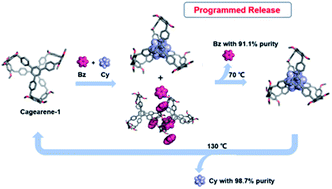Cagearenes: synthesis, characterization, and application for programmed vapour release†
Abstract
Here, we announce the establishment of a new family of organic molecular cages, named cagearenes, by taking advantage of a versatile strategy. These cagearenes were prepared via the Friedel–Crafts reaction by condensing two equivalents of a precursor bearing three 1,4-dimethoxybenzene groups and three equivalents of formaldehyde. Two cages, namely cagearene-1 and cagearene-2, are obtained and well characterized. The cagearene-1 solid exhibits the ability to adsorb benzene vapour from an equimolar benzene/cyclohexane mixture with a purity of 91.1%. Then, the adsorbed benzene molecules can be released from the cage at a relatively lower temperature, namely 70 °C, as a consequence of which, cyclohexane with a high purity was left within the cage solid. Heating the cage solid further at 130 °C led to the production of cyclohexane with a purity up to 98.7%. As inferred from the single crystal structures and theoretical calculations, the ability of the cage in programmed release of benzene and cyclohexane results from the different binding modes of these two guests.

- This article is part of the themed collection: 2022 Chemical Science HOT Article Collection


 Please wait while we load your content...
Please wait while we load your content...